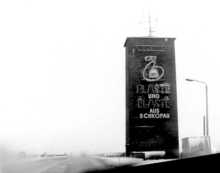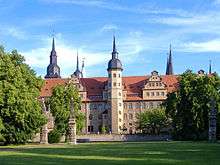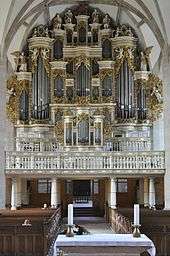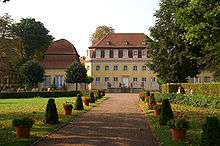Merseburg
Merseburg is a more than thousand-year-old town in Saxony-Anhalt, Germany.
Understand

Merseburg was one of the most important cities in central Germany during the early to high Middle Ages. It was first mentioned in a written document dating from c. 890 AD. Among German history adepts it is well known for the "Merseburg Incantations" or "Merseburg Charms" (Merseburger Zaubersprüche), a collection of medieval pre-Christian, pagan magic spells written in Old High German in the 9th or 10th century. In 968 Emperor Otto I founded the Merseburg bishopric. The city which was then near Germany's eastern border, remained an important religious centre until the 16th century, being home to a Benedictine abbey and a Romanesque cathedral. Merseburg was one of Emperor Henry II's favourite palaces. The diocese of Merseburg was rather small but contained important cities like Leipzig.
In the mid 16th-century Merseburg adopted Protestantism. The Benedictine monastery was disbanded and the bishopric's territory annexed by the secular Electorate of Saxony. From the mid-17th to 18th century, Merseburg was the residence of its own branch line of Dukes. Under Prussian rule after the Vienna Congress of 1815, it was the seat of a governorate, administrating the south of today's Saxony-Anhalt (including the much bigger Halle).

In the 20th century, Merseburg and more importantly its suburb Schkopau became production sites of the chemical industry. The Buna works in Schkopau, founded in 1936 to support the Nazi policy of autarky, i.e. independence from imports of raw materials, was the first facility to industrially synthesise rubber. During the division of Germany, Plaste und Elaste ("plastics and rubber") from Schkopau was an almost proverbial household name in East Germany. Much of the historical old town was torn down to be replaced by "socialist" architecture. After the reunification many workers lost their jobs in the now unprofitable factories and Merseburg lost about a third of its population since the 1980s (it had some 34,000 inhabitants in 2015). The Buna works are now a subsidiary of Dow Chemical.
Get in
By plane
Leipzig/Halle airport (LEJ IATA) is just 25 km from Merseburg. There is however no direct rail link, so you will have to take a taxi to get into town or change trains in Halle.
By train
- 🌍 Merseburg station. The train station is served by half-hourly local trains from Halle (10 minutes) and Naumburg (20–25 minutes), hourly from Köthen (40 minutes), Weimar (one hour), Erfurt (1:15) and Magdeburg (1:20). Arriving from more distant places, you will have to change in Halle.
By bus
From Leipzig, Bus line 100 connects to Merseburg, taking one hour from the central station (due to frequent stops). Riding the train takes about an hour as well, as you have to change in either Halle or Bad Dürrenberg.
By tram
Not a preferable option for travelers but an interesting anomaly is the 31 km long tram line from Halle to Bad Dürrenberg via Merseburg. A tram ride from Halle's city centre to Merseburg takes about 50 minutes.
Get around
By public transport
Hallesche Verkehrs-AG (HAVAG) operates the long-distance tram line no. 5 from Halle. Personennahverkehrsgesellschaft Merseburg-Querfurt (PNVG) is responsible for a network of urban and regional buses. The MDV combi tickets are valid in all local means of transportation in the Halle-Leipzig region and you may change from (local) train to bus or tram and vice versa using the same ticket.
See

- 🌍 Merseburg Cathedral (Merseburger Dom). Started in 1015, only the crypt, the circular towers accompanying the choir, the basements of the western towers and the lower parts of the transept including both apses have retained their original Romanesque forms, while most of the cathedral has been rebuilt in a Gothic style. The remarkable 13th-century glass paintings were lost but have been replaced by new ones in the mid-20th century, created by Charles Crodel who tried to uphold the medieval imagery. The Romanesque crucifix and a 12th-century baptismal font made from red sandstone still exist. In the southern enclosure, remarkable pieces from the cathedral treasure are presented, including valuable manuscripts like an illustrated 13th-century Bible, a Romanesque portable altar, a 13th-century ivory casket and reredos as well as the mummified hand of 11th-century anti-king Rudolf of Swabia. A facsimile of the famous pagan Merseburg Incantations is exhibited in the "charms vault". Moreover the cathedral includes a romantic tuned, 1850s grand organ by Friedrich Ladegast.

- 🌍 Episcopal Palace (Schloss Merseburg). Renaissance three-wing palace, built as an episcopal residence, later used by Prince-Electors and Dukes of Saxony, then by Prussian governors. Today it houses the district administration, school of music and a museum of cultural history. The latter provides an understanding of local history, displaying exhibits from prehistory to modern times. Some scenes of George Clooney's film The Monuments Men were shot here. The Palace is completed by a beautiful Baroque garden, part of the "Saxony-Anhalt Garden Dreams" project.
- Raven cage. A raven cage in the palace courtyard illustrates a local legend: Bishop Thilo von Trotha condemned one of his servants for stealing his golden signet ring and had him executed. The convict asserted his innocence, even after his head was cut off. Later, the ring was retrieved in a raven's nest, proving the servant innocent. The bishop regretted his overhasty verdict bitterly and ordered to capture and display a raven as a permanent reminder to never take a decision in an outburst of temper. Recently, the cage was enlarged and the previously single bird was given a mate to comply with modern ideas of animal welfare.
- 🌍 Merseburger Ständehaus (Estates' house), Oberaltenburg 2. Representative historistic building from the 1890s. Former seat of the parliament of the Prussian Province of Saxony (roughly equivalent to the modern state of Saxony-Anhalt). While the executive branch was located in Magdeburg, its representation body met in Merseburg.
- 🌍 Willi-Sitte-Galerie, Domstraße 15, ☎ +49 3461 212231, e-mail: info@willi-sitte-galerie-merseburg.de. Named after Willi Sitte (1921–2013), a main representative of East Germany's "socialist realism" school of art who developed his own style characterised by highly expressive postures and almost Baroque forms. The foundation collects paintings and graphics by Sitte and associated artitst. The gallery organises temporary exhibitions of different representatives of modern art, usually from the region.
- 🌍 Franzosen-Brunnen. Historic well that has existed since medieval times, in front of a passage between to benefice houses. It is named for a French officer who drowned in it in 1757. It was redesigned in 1928.
- 🌍 St Maximus' Church (St.-Maximi-Kirche). 13th-century Gothic three-aisled hall church. The steep Gothic revival tower was added around 1870.
- 🌍 Market place with Old Townhall. And 16th-century well.
- Remains of the medieval town fortification: 🌍 Schwarze Bastion ("Black bastion"). and 🌍 Eulenturm ("Owl tower").
.jpg)
- 🌍 German Chemistry Museum (Deutsches Chemie-Museum, DChM), Günther-Adolphi-Straße 2, ☎ +49 3461 4416195, e-mail: info@dchm.de. Tue-Thu 9AM-2PM, Fri 9AM-12PM, Sat-Sun and public holidays 10AM-5PM, closed on Mondays. When after the collapse of East Germany and reunification many chemical plants were closed down, the museum recovered their most notable equipment and apparatuses (some 5,000 objects in total). The biggest of which are displayed in an open-air "technology park" outside the museum. Among the most outstanding exhibits are a complete ammonia synthesis chamber from the earliest years of the Haber–Bosch process (named for its Nobel Prize-winning inventors) with a corresponding circulation pump, and a chemicals train. Admission € 3.50, children € 2.
- 🌍 Museum of aviation and technology (Luftfahrt- und Technikmuseum Merseburg), Kastanienpromenade 50 (on a disused airfield), ☎ +49 3461 525776. Tue-Thu 9AM-3:30PM, Fri 9AM-2PM, Sat-Sun 10AM-3:30 PM, closed on Mondays. Huge private collection of aircraft, fire engines, automobiles, motorcycles, cinematographs and computers, mostly of Eastern bloc manufactures. Its highlights are an Ilyushin Il-62 and a Tupolev Tu-134 airliner, MiG fighters, a Lockheed F-104 Starfighter, and a Mil Mi-8 helicopter. Admission € 8, children € 4.
Do

- 🌍 Domstadt Kino, König-Heinrich-Str. 7 (tram station "Merseburg Zentrum", 150 m from train station), ☎ +49 3461 352853. Smallish private cinema with special programmes. € 6.50–9.50.
- Merseburger Orgeltage, Thüringer Weg 28, 06217 Merseburg, ☎ +49 3461 342620, e-mail: info@skyhotel-merseburg.de. Festival of organ music at the cathedral and other local churches, with national and international guests.
Buy
Eat
- 🌍 Ritters Weinstuben, Große Ritterstraße 22 (350 m from market place), ☎ +49 3461 33660, e-mail: info@ritters-weinstuben.de. Mon-Fri from 1PM, Sat from 5PM, closed on Sundays. Upmarket restaurant in the old town, using regional products. Exquisite food and great service. Mains starting from € 13.50.
Drink
Sleep
- 🌍 Skyhotel Merseburg, Thüringer Weg 28 (on the B 91 road to Leuna). Modern mid-range hotel in a 10-storey tower (60 rooms and suites). On an arterial road 3 km south of the old town (16 minutes by tram). Panoramic restaurant and skybar on the top floor. Next to it is an aparthotel of the same brand. Double room € 53.
- 🌍 Radisson Blu Hotel Halle-Merseburg, Oberaltenburg 4, ☎ +49 3461 45200, e-mail: info.merseburg@radissonblu.com. Four-star hotel in an original 18th-century mansion (and a newer annex) in the heart of old town, right beside the palace garden and Estates' house. Double room € 72.
Connect
Nearby

- Geiseltalsee, 10 km southwest of Merseburg, largest lake in the Central German lake district, created by the recultivation of former lignite open-cast mines
- Bad Lauchstädt, 15 km west, mineral spa with Baroque architecture, gardens and a theatre inaugurated by Johann Wolfgang Goethe (20 minutes by bus)
Go next
- Halle, 15 km north, big neighbour, Saxony-Anhalt's most populous city, rich in history with an interesting old town, birth place of George Frideric Handel (10 minutes by train)
- Lützen, 20 km southeast, site of an important battle during the Thirty Years War, monument to Swedish king Gustavus Adolphus
- Naumburg, 30 km south, impressive Romanesque cathedral, home town of philosopher Friedrich Nietzsche, centre of the Saale-Unstrut cultural landscape and wine-growing region (20–25 minutes by train)
- Leipzig, 40 km east, trade city, cultural metropolis and economic "boom town" of East Germany (one hour by bus line 100 or train via Halle main station)
- Eisleben, 45 km west, Martin Luther's birth place, World Heritage site (1:15 hours by train via Halle main station)